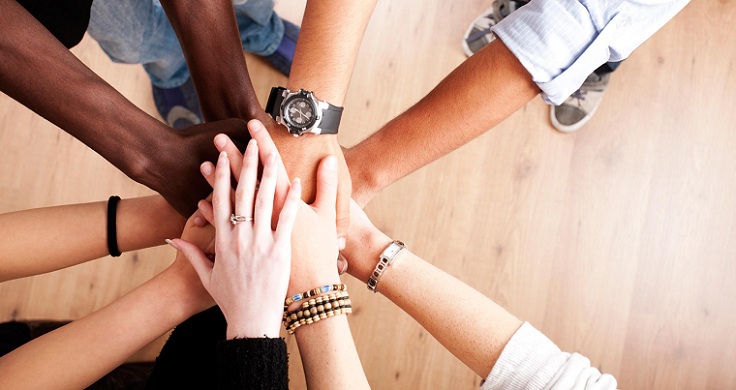10 steps to building a great team

A good team is not just a group of good people.
Studies show that the components of the concept of “productive team” are not always obvious, and sometimes they challenge the generally accepted ideas . Let's talk about it?
1. Look not only smart, look for sociable
What will help create a smart team ? Not only high IQ, but also teamwork skills.
')
Here are three factors:
- the average level of social sensitivity of group members;
- workspace in which there is no dominant person in the discussions;
- percentage of women in the group.
Women in this study tended to show a higher level of social sensitivity than men. In other words, groups work better on tasks when:
- their participants have good communication skills;
- when there are several women in the group;
- when in communication all members of the group have the opportunity to express their ideas.
2. Predict the success of a group based on the level of mutual sympathy of its members.
In accordance with the material "The advantage of happiness: 7 principles of positive psychology, ensuring success and productivity in the workplace":
... a study of more than 350 employees from 60 divisions of a financial services company revealed that the best indicator to predict the team’s achievements was how its members treated each other.
How well do they need to get along? Focus on the ratio of 5 to 1.
From the book "Monkey in the corner of the office: How to make friends, win in clashes and work better using the understanding of human nature":
... it turned out that 15 highly effective teams had an average ratio of positive contacts to negative ones at the level of 5, 6. For 19 low-efficiency teams, this coefficient was 0.363. That is, they had about three negative contacts for each positive contact ...
Do your team members pat on the shoulder, salute with a palm and embrace each other? “The teams where the most touches were observed were the most united and achieved the greatest success.” ★ .
From the book "Unconscious: How the subconscious controls the behavior":
Are those who hand-to-hand deal more successful in business? There is no evidence as to how well managers who like to pat on the shoulder manage. But a study conducted in 2010 in the city of Berkeley (USA) revealed a case in which incentive pats are really associated with successful teamwork. Scientists from Berkeley studied basketball, which involves teamwork every second and is famous for its developed language of touch. They found that the number of "fist-to-fist or palm-to-palm", touching shoulders, jumping on each other's shoulders, strikes to the chest, patting on the head, hugging the head, handshakes, greeting from the two palms, hugging was related to the level of interaction between team members.
The teams, where the greatest number of touches was observed, were the most united and achieved the greatest success.
3. The most creative teams are a combination of old friends and new people.
From the book “Imagination: How creativity works”:
“The best Broadway teams, by a wide margin, were those where different types of relationships took place,” says Utsi. “Such teams consisted of several old friends and newbies. This combination made it possible for artists to interact effectively : they could rely on a familiar structure, but at the same time some new ideas were added. They were comfortable with each other, but not too much. "
4. Success stories raise team spirit.
What creates team spirit? Success stories:
“Organizations that have a fascinating history often manage to create a special spirit of commitment among employees. It is this commitment that directly affects the company's success and plays an important role in creating a good corporate heritage, ”says Adam Galinski, a professor of ethics and management decisions.
5. To work effectively, the team needs clear goals.
From the book “Group Genius: The Creative Power of Cooperation”:
A study conducted among five hundred specialists and managers of thirty companies revealed that unclear goals were becoming the most significant obstacle to the effective work of the team.

6. Having defined the goals, assign roles.
The winner of the book: the science of victories and defeats says:
A clear distribution of roles and functions is one of the proven ways to improve the quality of teamwork. The equalization concept, providing for the same status and interchangeability of team members, is erroneous. Teams work best when people know their roles, but not necessarily all roles should be the same. Dr. Eduardo Salas of the University of Central Florida is one of the most cited scholars studying team effectiveness. He dedicated his life to understanding the great variety of team building and learning processes.
He analyzed teams working in the army, law, NASA and many corporate organizations. His opinion: only those strategies that are based on a clear distribution of roles, an understanding of who and what should do with increasing tensions bring a stable result.
7. Want quick team work? Focus on smoothness
From the work “Antidote: Happiness for those who can not think positively”:
... he worked with a team of Formula 1 mechanics and told them that they would be judged not by speed, but by style. Having received instructions to focus on the “smoothness” of work, and not on setting new speed records, they eventually began to work faster.
8. To treat the best in a different way is normal.
From the text of the publication “Winner: the science of victories and defeats”:
Does the special attitude to the “stars” of the team undermine the motivation of the rest of the team? Researchers have paid attention to the payment of NBA stars in comparison with their less famous teammates. In general, if some team members get what others consider an undeserved reward, it will negatively affect efficiency: team members will not work hard enough if they get overlooked. But if the attitude to the "stars" is fully justified, then this will not harm efficiency. "Stars" are changing. Leaders are under scrutiny, they are expected to achieve much higher efficiency.
9. Make a team of men and women.
Teams of men and women worked better.
For business management the best option is a group of two men and one woman. The difference in performance is due to a different approach to decision making. We observed that teams of three women were less aggressive in pricing, less invested in research, and more in initiatives related to social sustainability (compared to any other combinations of the sexes). And, finally, the hypothesis that such results were due precisely to the weak dynamics of the work of fully female teams was confirmed.
10. Research proves that the strength of a team is determined by its weakest link.
Trust in a team is not determined by the average participant, but by the weakest link:
The results of two studies show that trust in a team is significantly lower than trust in an individual. Statistically, it is at the level of the participant with the least reliability. In addition, unlike the average level of individual trust, an assessment of collective trust in a team will help to better predict:
(a) the likelihood of a deadlock in distribution negotiations;
(b) the level of joint achievements in integrative negotiations.
Want to build trust? Make your team laugh together ★ .
PS We recommend another article on the topic - Awesome productivity: 5 ways to increase team productivity .
Translated by Vyacheslav Davidenko, founder of MBA Consult .
Source: https://habr.com/ru/post/294738/
All Articles